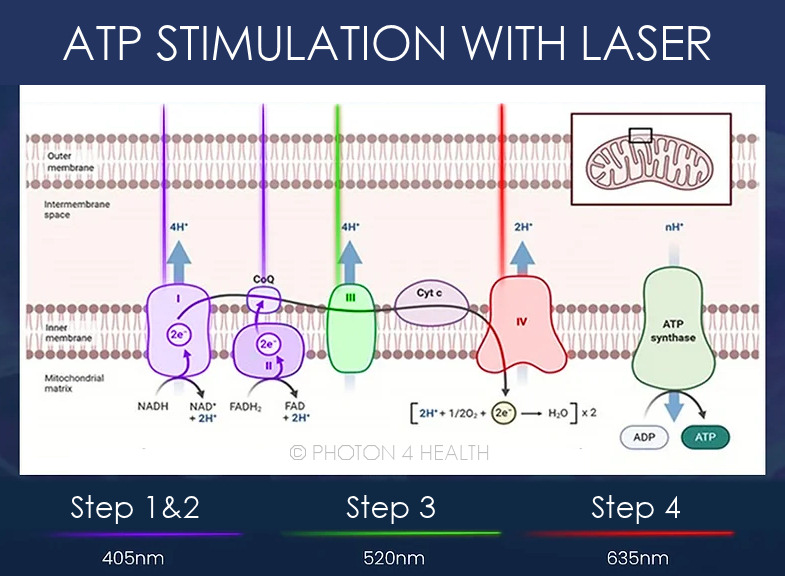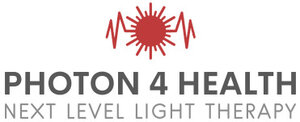ATP therapy
The use of laser therapy with red, purple and green laser light for the treatment of mitochondrial dysfunction and energy improvement.
When the laser light contains wavelengths from the red-green-purple parts of the color spectrum, all stages of the ATP energy generation process are stimulated.

How your body makes energy
Every cell in the body contains mitochondria. These little powerhouses generate ATP (adenosine triphosphate), which powers almost all essential functions of the body. ATP is preferably produced from glucose (sugar) and if not available from fats or proteins. To understand the importance of ATP, we like to use an example.The engine of a car burns gasoline. Gasoline is made from petroleum. You can't put petroleum in the gas tank of your car and expect the car to drive. If we compare this to the body, then see gasoline as ATP and petroleum as sugar/fats/proteins. You eat food that consists of sugars/fats/proteins but these raw materials must first be converted into ATP. Because ATP is the real fuel of all your body cells. Your mitochondria are responsible for this process and they do this in 4 conversion steps.
Sugars
Fats
Proteins
↓
1. Conversion into Acetyl-CoA
↓
2. Citric Acid Cycle (Krebs cycle) inside mitochondria
↓
3. Production of NADH and FADH₂
↓
4. Electron Transport Chain (in inner mitochondrial membrane)
↓
5. Proton gradient → powers ATP synthase
↓
ATP
Cells that require more energy, such as those in the heart, liver, muscles, and brain, contain more mitochondria. In addition to intracellular mitochondria, free-floating mitochondria circulate in the bloodstream.
Free-floating mitochondria
Free-floating mitochondria also circulate in the blood, independent of cells. In 2020, a French research group (14.) showed that there are millions of intact, functional mitochondria per milliliter of blood. They called this phenomenon "extracellular mitochondria" or "free-floating mitochondria". These mitochondria play a major role in our health as both photon transmitters and energy factories, and we have a whole lot of them. On average, 5 million to 50 million mitochondria per milliliter of blood, so certainly not a negligible amount.Mitochondrial Dysfunction: Disruption of Energy Production
When energy production in mitochondria is running smoothly, the body has sufficient energy for normal function, growth, and healing. However, when the process is disrupted, mitochondrial dysfunction occurs. Energy levels drop, oxidative stress increases, cell signaling is disrupted, and inflammation occurs. Decreased ATP levels can lead to fatigue, hypersensitivity, and chronic pain.Mitochondrial dysfunction occurs when mitochondria are not working efficiently. Fundamental causes of mitochondrial dysfunction include:
Oxidative Stress
Energy production in mitochondria generates high levels of free radicals, specifically reactive oxygen species (ROS), which can exceed antioxidant levels, leading to oxidative stress damage, decreased function, and inflammation.
Tip: Hydrogen therapy can help reduce oxidative stress and promote ATP turnover.
Microorganisms such as viruses, bacteria and fungi
Mitochondrial dysfunction caused by viral diseases is a major underlying cause of chronic diseases, including long-term COVID and chronic EBV (Epstein Barr infection). Chronic Candida and Lyme disease are also major causes of mitochondrial dysfunction.
In general, microorganisms can damage the delicate internal structures of the mitochondria and lead to increased production of free radicals which causes enormous damage. The mitochondria can no longer produce energy efficiently, leading to chronic and often severe fatigue.

Environmental factors
Exposure to environmental toxins, such as heavy metals, pesticides, and certain medications, can disrupt the integrity of the outer and inner mitochondrial membranes. They can also disrupt enzyme activity and damage mitochondrial DNA replication and repair mechanisms. Standard over-the-counter and prescription nonsteroidal anti-inflammatory drugs, including aspirin, ibuprofen, and diclofenac, will inhibit the electron transport chain and impair mitochondrial function.
Age-related changes
Overall mitochondrial function declines with age, partly due to accumulated damage from oxidative stress and decreased efficiency of repair mechanisms. Age-related mitochondrial dysfunction contributes to age-related diseases and worsens overall cellular function.
Sedentary lifestyle
Lack of physical activity leads to decreased production of oxidative enzymes, increased free radical damage, and decreased activity of the electron transport chain.
Metabolic Disorders
Prediabetes, diabetes, obesity, and metabolic syndrome can compromise mitochondrial function by disrupting glucose breakdown, damaging mitochondrial membranes, and increasing oxidative stress and free radical damage.
Cellular Threat Response
When mitochondria become dysfunctional due to age, lifestyle, and metabolic disorders, all systems in the body, including the immune system, are operating at suboptimal levels. Poor lifestyle that leads to suboptimal mitochondrial function also leads to chronic low-level inflammation, which causes further mitochondrial dysfunction and a self-perpetuating cycle of fatigue and myriad chronic conditions. When an inflammatory disease such as COVID, EBV, Lyme, or Candida is added to the already dysfunctional system, the immune system is less equipped to fight it off and chronic conditions arise that Doctors claim to have no cure for. They are only ready with their symptom suppressing drugs. Which certainly help, but absolutely do not cure the cause just mentioned. If you want to heal, one of the most important steps is to restore ATP production.
CDR mode
When you are (chronically) exposed to microorganisms or toxic chemicals, the mitochondria go into the cell danger response CDR mode. An evolutionary response that protects cells from damage. It is caused by chemical, physical or biological threats.
In CDR mode, mitochondrial activity switches from energy production to cell defense in the cell to support the immune system. In other words, the mitochondria downregulate and divert their energy to the immune system.
When the mitochondria switch to promoting immune defense, there is little energy left for other functions. This is the underlying cause of fatigue that usually accompanies any illness. Healthy mitochondria have sufficient reserve to continue generating energy during an illness, albeit at a lower level. When the mitochondria are functioning properly, energy levels return to normal after the body has fought off infections.

Cold laser light will stimulate the production of ATP and improve the function and stability of the mitochondria by delivering blue, purple and red photons into the cell. When photons from blue, red and green lasers strike certain atoms in the inner membrane of the mitochondria, where the electron transport chain takes place, the energy will push the electron from that atom to a higher energy level, where an electron acceptor in the electron transport chain can pick it up. In plain language, red, purple and blue pairs of laser light are made up of photons. These photons stimulate the conversion of nutrients to ATP.
It is believed that photons in the visible laser light spectrum affect complexes I, II, III and IV of the electron transport chain. Some wavelengths used in cold laser therapy are particularly effective at different points in the electron transport chain. However, using the correct wavelengths (light colors) is critical to achieving an excellent therapeutic response.
Laser light in the 400 to 450 nm range (blue and purple) stimulates complexes I and II. Complex I is the largest and most complicated complex of the electron transport chain. Any dysfunction at this point will affect the energy production that the subsequent complexes can produce. Laser therapy using the purple wavelength provides sufficient photonic energy to produce the necessary electron jumps to make complexes I and II function more efficiently.
Complex III is stimulated by laser light in the 500 to 560 nm range (green). Laser light in this range can stimulate the processes related to oxidative phosphorylation at the ATP synthase complex, the final step in ATP production. Complex IV is only stimulated by laser light in the 600 to 670 nm range.

By stimulating the activity of the ETC complexes, the mechanism for ATP production is restored and ATP production in the mitochondria is increased. Free-floating mitochondria in the bloodstream absorb the red, green, and purple photons and distribute them throughout the body, allowing radiation to the bloodstream, such as the inner wrist, to have a systemic effect far away from the site of radiation.
Restoring Mitochondrial Function with ATP Laser Therapy
When mitochondria become dysfunctional, their normal function can often be restored with laser therapy. That is why we call it ATP Laser Therapy.
Laser therapy with red, green, and purple lasers can help stimulate energy production in the mitochondria. These wavelengths target the entire electron transport chain of the mitochondria. Our ATP laser therapy is a scientifically proven highly effective therapy for improving the entire body and energy.
In addition to ATP laser therapy, all our devices are equipped with biophoton (laser) therapy, read more about it HERE.
In addition to ATP laser therapy, all our devices are equipped with TESLA magnetic field therapy, read more about it HERE.
In addition to biophoton therapy, all our devices are equipped with Brain Frequency Therapy, read more about it HERE.
References
- Sreedhar A, et al. Mitochondria in skin health, aging and disease. Cell Death Dis. 2020;11(6):444. PubMed. https://pubmed.ncbi.nlm.nih.gov/32518230/. Accessed Feb. 27, 2024.
- Meeus M, et al. The role of mitochondrial dysfunctions due to oxidative and nitrosative stress in chronic pain or chronic fatigue syndromes and fibromyalgia patients: peripheral and central mechanisms as therapeutic targets? Expert Opin Ther Targets. 2013;17(9):1081-1089. PubMed. https://pubmed.ncbi.nlm.nih.gov/23834645/. Accessed Feb. 27, 2024.
- Zhou B, Tian R. Mitochondrial dysfunction in pathophysiology of heart failure. J Clin Invest. 2018;128(9):3716-3726. PubMed. https://pubmed.ncbi.nlm.nih.gov/30124471/. Accessed Feb. 27, 2024.
- Kumaran S, et al. Age-associated decreased activities of mitochondrial electron transport chain complexes in heart and skeletal muscle: role of L-carnitine. Chem Biol Interact. 2004;148(1-2):11-18. PubMed. https://pubmed.ncbi.nlm.nih.gov/15223352/. Accessed Feb. 27, 2024.
- Naviaux RK. Metabolic features of the cell danger response. Mitochondrion. 2014;16:7-17. PubMed. https://pubmed.ncbi.nlm.nih.gov/23981537/. Accessed Feb. 27, 2024.
- Ahmad M, et al. Biochemistry, Electron Transport Chain. In: StatPearls. Treasure Island (FL): StatPearls Publishing. September 4, 2023. PubMed. https://pubmed.ncbi.nlm.nih.gov/30252361/. Accessed Feb. 27, 2024.
- Sharma LK, Lu J, Bai Y. Mitochondrial respiratory complex I: structure, function and implication in human diseases. Curr Med Chem. 2009;16(10):1266-1277. PubMed. https://pubmed.ncbi.nlm.nih.gov/19355884/. Accessed Feb. 27, 2024.
- Du Z, et al. Structure of the human respiratory complex II. Proc Natl Acad Sci USA. 2023;120(18):e2216713120. PubMed. https://pubmed.ncbi.nlm.nih.gov/37098072/. Accessed Feb. 27, 2024.
- Kassák P, et al. Mitochondrial alterations induced by 532 nm laser irradiation. Gen Physiol Biophys. 2005;24(2):209-220. PubMed. https://pubmed.ncbi.nlm.nih.gov/16118473/. Accessed Feb. 27, 2024.
- Toledo FG, et al. Changes induced by physical activity and weight loss in the morphology of intermyofibrillar mitochondria in obese men and women. J Clin Endocrinol Metab. 2006;91(8):3224-3227. PubMed. https://pubmed.ncbi.nlm.nih.gov/16684829/. Accessed Feb. 27, 2024.
- San-Millán I. The Key Role of Mitochondrial Function in Health and Disease. Antioxidants. 2023;12(4):782. PubMed. https://pubmed.ncbi.nlm.nih.gov/37107158/. Accessed Feb. 27, 2024.
- Karu T. Mitochondrial mechanisms of photobiomodulation in context of new data about multiple roles of ATP. Photomed Laser Surg. 2010;28(2):159-160. PubMed. https://pubmed.ncbi.nlm.nih.gov/20374017/. Accessed Feb. 27, 2024.
- Sammons T, et al. Assessing the Impact of High Photon Energy Wavelengths on the Treatment of Chronic Neck and Shoulder Pain. Evid Based Complement Alternat Med. 2023;2023:6672019. PubMed. https://pubmed.ncbi.nlm.nih.gov/37829623/. Accessed Feb. 27, 2024.
- Blood contains circulating cell-free respiratory competent mitochondria The FASEB Journal, 2020 https://pubmed.ncbi.nlm.nih.gov/31957088/

Need help?
Call us 0031611049629







